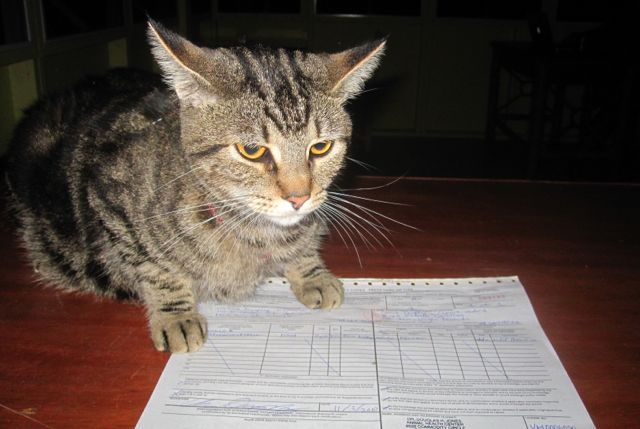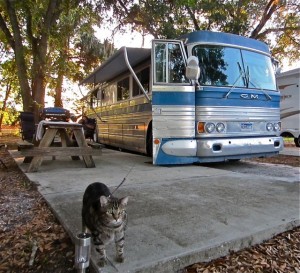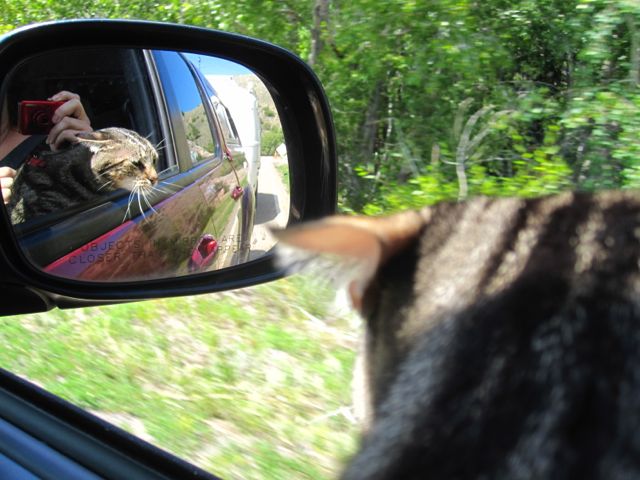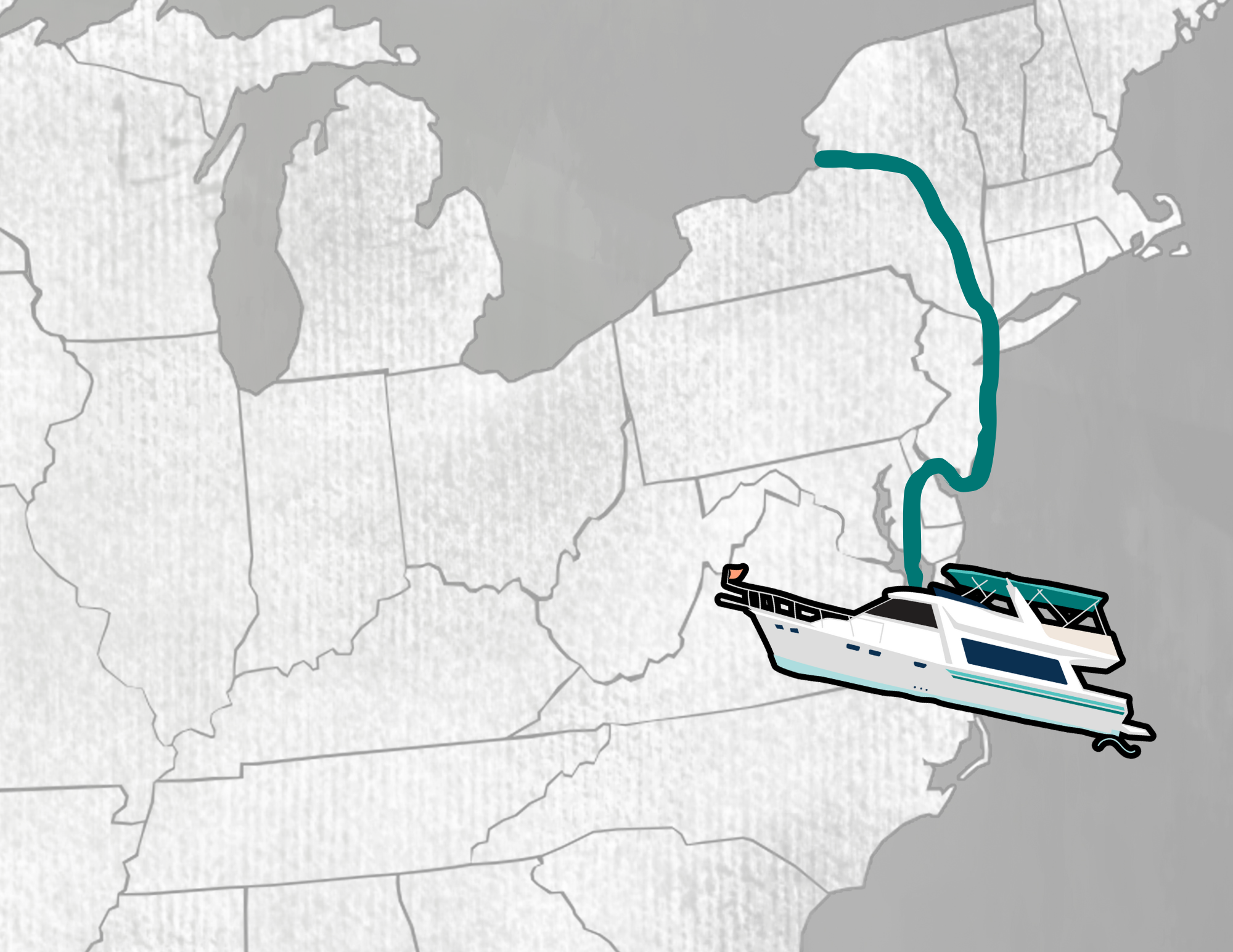
<— Read Chapter 5: Green Your Travel — Environmental NomadismRead Chapter 7: Community Aspects of Nomadic Travel —>
As we have discovered — if wanderlust is your calling, you don’t necessarily have to give up having pets in your life. But you might need to make some compromises in your style of travel.
Take Your House With You

The easiest way to integrate a mobile lifestyle with pets is by selecting a style of travel that keeps your house with you so your pet is always at home. This might include an RV or a boat.
It’s not uncommon at all for folks traveling about in mobile homes to have pets onboard. By and large, most campgrounds have no problem with pets, making it even easier to find places to park.
Here are some inspiring examples of folks traveling with pets:
In RVs:
- Louise & Sean – This duo has been traveling the US in an awesome bus conversation with their zoo, boondocking most of the time. They currently have two cats, but have previously had a fish tank on board. And sadly, their beloved dog Opal recently passed away. They are currently shopping for a live aboard boat to move on next.
- Lynne – Lynne travels part of the year with her companion Millie – a yellow lab – in a Winnebago View.
- Cat & Bryan — This young duo is traveling the US full time in a motorhome with a cat, bird, a bearded dragon and hermit crabs. Wild!
- Nina & Paul – After a good amount of international travel, these two with their dog and 2 cats are now traveling the US via motorhome.
- Rene & Jim — This duo took off in a fifth wheel after their dog Jerry was diagnosed with cancer. They enjoyed two years on the road with him before he passed on, and now have a younger tripawd family member, Wyatt. They also run a community site for three-legged furry family members.
- Ramblecrunch – Canadians Renee and Mark are currently traveling Europe by RV with their 10 year old daughter and Scout, their dog.
In boats:
- Steve — The original technomad Steve Roberts is finishing up preparations on a geeked out sailing vessel, Nomadness. Onboard will be Steve’s cat Java.
- Jessica — Jessica has been sailing with her pooch, Kip McSnip — and together they wrote the book, Doggy on Deck, on sailing with dogs.
- Laura & Patrick – This family aboard s/v Just a Minute is ending a 3.5 year sailing journey in Mexico traveling with a dog named Rudy.
As with having pets in any sort of home, there are things to keep in mind when keeping a pet in your mobile home:
-

Kiki hiking with us in Colorado Always be aware of temperature and make sure that your home is comfortable for your pet, particularly when you are away from it.
- Make sure your pets get enough exercise — most mobile homes have far less room to play and run around in.
- Lining up vets, grooming and pet sitters across the country (and out of country) can be a challenge. We tap into friends, fellow travelers, and Yelp for recommendations. Make sure you keep current copies of all vet records and vaccine certificates, and take them with you to each vet appointment to avoid unnecessary treatments and vaccines. These are also helpful if you decide to cross borders. Tip: Some of us US domestic travelers have chosen Banfield Pet Hospital as our vet of choice – they have offices in many Petsmarts across the country, and have a centralized database of our records. They also offer an annual plan that includes all vaccinations and office visits.
- Realize that everywhere you take your home may not be a welcome environment for your pets. Many festivals we attend have strict Leave Your Pets At Home’ rules. Though when we explain that bringing Kiki with us actually is ”Leaving her at home” we’ve had some luck getting the rule waived.
- Pick brands of food and other supplies that are available nationwide, and keep close tabs on supplies. If you run out, you may not be nearby a pet store to run in and get more. Some folks even prepare their own food for their pets from raw foods – which are readily available most places they go. We have food shipped in on our Amazon.com Prime account to wherever we’re at, so that we are sure to keep a consistent brand always available for our cat.
- Be in the know about local predators where you stay, especially if you let your pet outside – and always supervise them! Even supervising Kiki on a leash – we’ve had local campground cats get in fights with her, a scary rattlesnake bite and a flea infestation.
Other Forms of Travel
Living in a RV or a boat however is not the only form of full time travel that folks explore with their pets. It is more difficult but still possible to travel with animals via planes, buses, backpacking, bicycling, and more.

In the 2010/2011 winter, we had an opportunity to spend 5 months in the US Virgin Islands – and we took Kiki with us. In one day she got to travel by car, shuttle, airplane and ferry boat, she’s such a trooper! As the USVI is a US Territory, the hoops were pretty easy to jump through – but it did take some research to make sure we wouldn’t encounter any snags.
For instance, our airline told us we’d need a health certificate from a vet, so we paid to get one (believe it was around $60 for the vet appointment and form). But not a single person along the way asked to see it – turns out, the airline was misinformed about the requirement. We also paid to carry Kiki in the cabin in a pet carrier placed under the seat in front of us – to the tune of $125 each way. Again, no one along the way ever asked to see her ticket.
All and all tho, Kiki traveled amazingly well and only got upset after going through 2 suddenly aborted landings in the middle of a highly turbulent approach to the island (heck, most the passengers were freaking out too!).
Last year during our bus hunt, we traveled extensively by train across the US. However, Amtrak doesn’t allow non-service animals on board – and we didn’t want the complication of traveling with Kiki while we needed to focus on finding our next home on wheels. So we made the decision to leave her with ‘grandmeow’ for a while. When we had our bus ready, we flew back to get her and bring her home.
Traveling with a pet does take making some compromises, and we do lose some flexibility by taking on the responsibility of creating a safe and comfortable environment for our cat.
International Travel

International travel is also possible with your pets, but quarantine, vaccination, permits and importation procedures can make this a logistically challenging and expensive venture. The added levels of cost and complexity make finding an extended pet sitter a very reasonable alternative – which is what we plan to do with Kiki when we start mixing in a month or two of international travel at a time.
But, that doesn’t mean people don’t make it happen. Based on the examples of folks traveling internationally with their pets, such as Renee & Mark above and folks & critters at The Road Unleashed, they seem to explore within quarantine borders and only rarely switch to a new location that requires going through the process over again.
For researching taking your pet into other countries, here are some resources to start with:
The USDA maintained list of animal export regulations
Pet Travel’s Immigration Guide
Ramble Crunch’s Guide to Taking a Dog to Europe
Pet Friendly Travel’s Guide to International Pet Travel
Don’t rely on these online resources however – the best and most accurate source of information will be directly contacting the country’s embassy that you plan to visit.
Other Options For Pet Love
If you are craving the love of a furry companion, there are alternatives even if it isn’t practical for you to bring your own pet on the road.
- Finding opportunities to pet sit can be a very rewarding experience to get your snuggle time in, helping folks out and perhaps even earning a few bucks or free lodging in a new location. Christy & Kali of Technosyncratic have been finding housesitting gigs around the world to get their pet love time in.
- Many campgrounds seem to have resident stray cats that love the attention of folks passing through.
- Volunteering at pet shelters or rescue organizations as you travel can also be an excellent way to get time with animals and help out.
- Visit lots of friends along the way who have pets.
Our Pet Life

When Chris and I set out for our first seven month trial run of traveling together in 2007, we decided that my cat Alma was not meant to be a traveling cat. So Alma stayed behind with my ex – and we both thrived in our new homes.
But there was a furry void in my life, and Chris and I agreed that we would stay open for a travel compatible cat to join us on our journey. In the meantime, we took a few petsitting opportunities and enjoyed the companionship of animals whenever we could as we visited people and stayed at campgrounds.
While visiting some friends on a ranch in Oregon in December 2008, a seven-week-old bundle of cuteness named Kiki stole our hearts. A quick test trip proved that she was travel and allergy compatible, and she has been traveling with us ever since. Having literally grown up on the road, she has grown to be a natural traveler – having now traveled by truck, bus, car, airplane and ferry. We trained her from day one to walk on a harness and leash, and she’s highly adaptable to new situations – a perfect traveling cat!

<— Read Chapter 5: Green Your Travel — Environmental NomadismRead Chapter 7: Community Aspects of Nomadic Travel —>
Resources:
Almost Fearless addresses a lot of tips and issues for traveling abroad with your pets.
Pet Corner – Nina and Paul of Wheeling It offer a lot of practical tips on traveling with pets, from RVs to international travel.
How to Travel with Pets – A website maintained by digital nomad Anil Polat, dedicated to the topic of traveling with pets.
What happened to the eBook version of this series?

We used to offer an eBook version of this content on a ‘Pay as you Wish’ basis. That book got so out of date and we have no time to keep it updated – so we took it down.
We do our best to upkeep the segments in this blog series, but realistically can’t see republishing the book edition.
In November 2018, RV Love released their brand new (professionally published) book – Living the RV Life. It goes over a lot of similar content to this series (and more) on RVing. We highly recommend picking up a copy!
You’re of course welcome to browse the No Excuses: Go Nomadic series online for more of our tips & tricks on the logistics of nomadic travel.
If you do appreciate this series or the content on our blog, we always LOVE hearing your appreciation – leave a comment, leave a tip (link at bottom of every page) and/or share this post. Thank you!


As an expat we traveled the world and lived in many places always with our pets. Our rule was that if it was not possible for our ‘fur kids’ to join us we would not go.
During our first stay in the USA from 1999-2002 I became involved in dog rescue, Border Collies because we had one ourselves, they were rarest that time in the Netherlandsan I could not believe the many Border Collies I found here in shelters and even euthanized after the mandatory 3 or 5 day hold.
We rescued one dog at a time and found homes in various places in the country, where there would be a ‘working’home for the with some sheep or other type of jobs(2 of my dogs became ranger companions!)
I had to ship dogs all over the country and wanted to add to your information that if you need to travel with a dog on a flight the dog (or cat in some cases like international) will most of the time travel as cargo.
This will in most cases work out fine. There is just one thing a lot of people are not aware of and that is that airlines have tempature restrictions for pets who travel as cargo.
This has 2 reasons, if it’s too warm and they need to stand in the turmac for a long time the cargo hold area is not cooled than, so it would be much to hot soon for pets
The same goes for the cold, if it’s too cold they will freeze. So they have temperatures embargoes. Check with the airlines what the cut off temperature is. It’s a nightmare when you are ready to check in and your pets can’t fly with you.
Happy travels!
—
Christine – traveling with 2 dogs and 2 cats
Hi guys! I missed this post when it came out, but thanks so much for including us. Our Jack Russell spent a year in Europe and Turkey with us. We chose to RV so he’d be comfortable. There were challenges, but nothing we couldn’t deal with, and it end up being a wonderful experience for us all.
When we got back I wrote an ebook about the mechanics of flying a dog from the US or Canada to Europe. I’ll include the link here because the book could be useful to someone on this thread. (The international pet-import requirements are a bear to figure out the first time you do it.) But if you don’t want a link, please just delete it!
Cheers!
http://ramblecrunch.com/how-to-fly-your-dog-to-europe/#.UptPZGRDuyg
i have a 6yr old female cat(mimi) who has always been a house cat. I will be traveling with a friend who has another cat and dog who both go in and out of the house. How do I get her ready? I would like her to be on a leash so she doesn’t get lost. I have 1 year to do this.
Hi Paula – as we got Kiki as a kitten while we were already on the road, we’ve not gone through the process ourselves. But would start getting your kitty used to wearing a harness now, and going on car trips. And if she’s not already, get her microchipped. Best wishes.
Glad y’all have had such luck with traveling with pets. We’ve done it with and without, and I personally think you have so much more freedom sans Fido. Maybe a cat would be easy to keep onboard but our dog was just too territorial for RV parks, state parks, etc (not that he’s mean, he’s just got one helluva bark). Plus, National Parks don’t typically allow pets on trails and frown heavily on them being left in your rig.
But then again, I’m not exactly a dog person (sorry!) anyway.
Another good example of a nomad traveling with a pet is Alison, who is a photographer living on the road with her dog, Max. You can learn more about them here: http://alisontravelsblog.blogspot.com/
I always take my dogs on road trips. For international travel I have an absolutely AWESOME house/pet sitter. I’d love to take them, but as you mention it can be expensive and sometimes complicated. I always way the stress of travel versus the reward. If the reward outweights the stress, they come along. We are headed to Alaska (via Canada) in May. I know they will love it!
Thanks for the shout-out! I’d like to add that we’ve been happy with using the Banfield brand of vet clinics for our mobile pets. They are part of many Petsmart chain stores and can be found all over the US. All the clinic records are on a single computer network, so any clinic can call up information about our pets. This reduces the need to repeat tests as we move from Banfield to Banfield during our travels.
One of our kitties has chronic kidney disease and needs regular blood work to monitor her status. Knowing we can do that at Banfield without starting from scratch with another vet is very helpful!
And speaking of Petsmart, if you have an animal that needs a prescription diet like for kidney or thyroid disease, Petsmarts with Banfield carry most types. Because they are a large chain, they purchase in bulk and therefore have considerably lower prices on these Rx only foods. Even if you don’t use the Banfield vets, Petsmart will honor other vet’s written prescriptions. Sort of like a Walgreens or RiteAid for furkids!
Thanks for additional info on Banfield! We switched to them while we were at Choo Choo and Don took us there when Kiki was having a problem. After hearing from so many other full timers who utilize them, we decided to give them a shot.
I do like the feeling of not needing to seek out a vet for her … we just look for the nearest Banfield, where we know they already have her records and she’s prepaid for the appointment.
Love the adventurous photos of Kiki… she is such a cool cat!
Actually a big part of our decision to travel by RV instead of backpacking or jetsetting was due to our sweet, old, fur-baby, Cleo.
She was 12 years old when we started and most people thought we were crazy to bring a cat on the road. Well, she’s been great… but hasn’t left the motor home except for a stay at “Grandmeow’s” house. (Ha, great name, btw.)
A note on PET FOOD that has helped us save money, maintain a high quality of food everywhere we go, and has improved overall health of our ol’meower. RAW TURKEY!
We can by the raw (ground ’cause she doesn’t have teeth anymore) turkey at any grocery. It’s less expensive per feeding then the canned Science Diet we fed her previously. You can buy it fresh or frozen or in patties.
Then we add a supplement (you can find at feed stores or on amazon) Nupro – it’s kelp, flaxseed, fish meal, alfalfa, and enzyme. This adds the nutrients that a carnivore would naturally get from eating other animals (like a mouse or lizard etc.).
Cleo has been “Raw” for two years and her health has improved tenfold. Better coat, no more puke-fest, and her poop – it hardly smells!! Big perk. It’s so healthy, most forums I’ve read from people who’ve been feeding raw for the whole life of the animal, have never needed vet attention!
Cheers! And thanks for the great post.
As a long-time raw-feeder (and member of many raw-feeding groups) I have to advise that regular ground turkey with Nupro is not a complete diet. I’d suggest adding ground bone (for calcium – absolutely critical) and organs to your meal, as well as supplemental taurine. All of these provide critical vitamins and minerals which the Nupro alone does not. Please have a look at this site which has great directions for making your own home-made raw:
http://www.catinfo.org/
Nina
P.S. I’m a huge raw-fan and we raw-feed on the road too. I buy the organs from local farms.
Oh, I have questions… Do you grind the meat yourself? In your RV? How much do you freeze at a time? Have you ever had any disasters with store bought meat? Where do you buy the calcium? How does being on the road change the way you make/get/maintain the diet?
I do feed her livers & hearts & whole raw fish from time to time.. when we find it (more in the south!) or catch something fishing. I look at these as super treats!
Our simple efforts have yielded such improvements (health/behavior/coat etc) over the processed canned/dry foods I wouldn’t want to change much. Hey, the proof is in the poodding, right! (Poop jokes make me giggle.) Anyway…
(Poop jokes make me giggle.) Anyway…
Thanks for the tips/website Nina!
PS – sorry Technomadia for hijacking your post.
Hijack away This is relevant stuff to the topic, and I’m sure others will benefit from it.
This is relevant stuff to the topic, and I’m sure others will benefit from it.
Jeanette (and Cherie)
Hope you don’t mind the longer reply!
Most raw-feeders try to target a diet that is approx. 80% meat, 10% bone and 10% organ (of which half liver). That’s as close as you can get to “whole prey” (like mice), so that’s what you try and duplicate at home.
We currently 100% raw-feed our dog and she’s happy to crunch everything (meat, bone, organs) so we feed everything to her as “whole” as possible.
My cats are still in transition to raw (unfortunately they never learnt to eat real food), so for them we can’t feed whole. I currently give them just little bits of raw meat choppped up in their canned food (just to get them used to the idea), but when we fully transition my plan is to buy a proper grinder (e.g. the Tasin TS-108) and grind whole meat, bone & organs to freeze as a complete meal. The catinfo site has fabulous info on the mixer & recipe. Look at their “making cat food” link.
We usually buy and freeze about 7 days of raw food at a time.
The meat/bone I buy directly from the supermarket. Never had any problems with it. I usually ask the butcher to chop it fresh for me.
Organs I buy 100% grass-fed from farms along the way (which I find on http://www.eatwild.com – we’ve even driven the rig onto a few farms!) and then chop-up into small pieces that I store in ziplock bags in the fridge and serve to doggie daily.
For calcium I currently use whole bone. For the cats we’re not transitioned yet, but will grind the bone for them. Whole bone is best. It is possible to use calcium supplements or egg shells, but you need to follow a recipe because cats need a very specific ratio of calcium:phsohorus.
Do hope that’s helpful! The best link I can give is the making cat food link.
Don’t want to hog-up the page so do feel free to e-mail me if you want more info. I can go on and on about raw-feeding LOL
Nina
Glad I checked back here. I feed my animals raw too. I have actually reversed my 2 cat’s chronic renal failure with my raw turkey recipe – over a year and half and they are doing great on it. Much better than the kidney prescription food vets sell. raw turkey as fatty as I can find, a vitamin B liquid, calcium carbonate, aluminum hydroxide, salmon oil, yogurt and kefir, and Aunt Jeni’s vitamin & herbal blend. I buy ground meat for the cats but whole meat and pumpkin for the dog to chomp on.
That’s awesome, I’d love to take my kitties on all of our family road trips. I bet they’d love staring out the windows at all the cars, people, and animals!
Great round-up of pet travel & cheers for the mention! We took our cats to Asia (and back) and believe you can go just about anywhere with your furry family. We’re totally all about the kitty harness too. Best thing for cats ever!!
Nina
When we were researching potentially slow-traveling the world with Kiki, we were surprised by how many places it was relatively easy to take her… if coming from the US.
It did seem however that moving between some countries could be more hassle/problematic than traveling to/from a 1st world country like the US/Canada/UK, etc. And going to Australia seems particularly tricky with their extended quarantine laws.
Yup, we actually considered living in Australia for a few years when we were based in Asia, but had to give it up because of the quarantine laws. Hawaii is a hassle too, unfortuantely.
Nina
Bringing my pets along was the big driver to my getting the van. After my 1st trip with my 2 enemy cats, I got a dog shortly after because it was clear the whole van thing would work well with pets and I missed having a dog after my last one died. The climate control (insulation/fans/AC) and ability to always have water ready for them makes a big difference to their comfort and safety.
People should not use their experiences with how their pets behave in a car to determine how they will do in an RV. My cats hate/fear the car but are completely comfortable in the van – and they are elderly. I guess the van looks like home to them (and they do have water and litter box at all times) so they react accordingly. They also stopped fighting in the van. They still hate each other but the obnoxious bullying by the one stops. Oddly, the restricted space helps.
I also use harnesses and leashes on the cats at all times. I rigged up a long rope for the dog so she can be easily leashed at the door when stopped. Training has made her much easier to travel with. I did make the decision that I won’t stay at places that do not allow dogs and finding her places to run are part of the fun. I’ve spent longer than planned at places because she was having so much fun. But I’m careful that she isn’t obnoxious and always pick up after her deposits. Being a single female, I feel safer having the dog, even tho she is all friendliness.
Do you restrain your cat while underway (carrier)? I don’t. They hang out in different places in the van, including my lap, mostly sleeping.
Great point to not judge your pet’s ability to travel by how they react in a car. Not only is a car not their home, most pets have only been in a car in stressful situations – such as going to the vet.
We did restrain Kiki when she was a kitten and was quite…. um.. energetic. But now that she’s mellowed out, she rides in the bus wherever she likes. She generally just curls up on the couch and snoozes. She loves having inflight food and potty.
Love this! Our dogs are traveling with us now in Europe (though we aren’t really doing any of the systems you mention) and it’s been amazing.
And, I don’t want to hijack your thread but, yes, international travel is possible (and actually quite easy in Europe)! We’ve got a whole site devoted to traveling with pets in Europe here: http://theroadunleashed.com
Thanks guys.. we’ll get that added to the post!